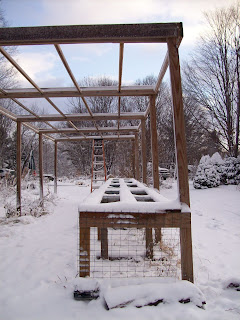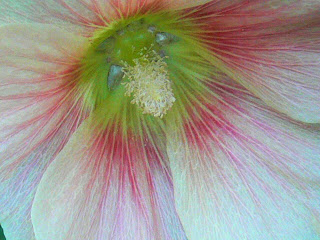
Sunday, December 9, 2007
6:30 PM has already arrived and it seems like just minutes ago that I looked out the office window at 6:30 this morning and saw the sun screaming through the trees and turning the clouds red like the pine grosbeaks that visited the bird feeders a few days back. It was a powerful color, bumpy in places, and interrupted by gray-blue background skies.
 Red at night, sailors delight, red in the morning, sailors take warning. As I write, it is 15 degrees, clear and calm. During the day here we had a few short lived squalls but the snow fluff that materialized accumulated very little.
Red at night, sailors delight, red in the morning, sailors take warning. As I write, it is 15 degrees, clear and calm. During the day here we had a few short lived squalls but the snow fluff that materialized accumulated very little.
Today I continued to teach myself Dreamweaver CS3. By the time spring arrives I'm hopeful that I'll have mastered enough to present a new website for gardeners to view and order from. Everyone learns differently and I'm a visual learner so the online tutorials and picture books are getting me where I need to be. I have to take breaks and refresh myself so Karl the wonder dog and I go for walks or rides when I get hung up. Tonight I will begin working on images and then when I tire, I'll look at background and text colors.
I'm open to advice on colors. I always listen to advice but don't always use it. When I did our site four years ago I used a cream papyrus font and a dark red background. I was cautioned not to. Today "fonts" are out, cascading style sheets are in and non-dithering colors are recommended. I thought I did well to build a site with just me and a book but now I am told that I have to test the site in a variety of browsers and be sure not to forget to go to Adobe's Device Central and check out the emulation on a variety of hand helds like Blackberries and mobile phones. Good advice but mind boggling to an aging gardener!
Today I helped Gail rearrange some furniture in anticipation of my grandson's arrival next week. He's a year and a half old and his middle name is "inquisitive". I'm told he's too strong at times for his own good so my office just inherited two 30" tall cast iron garden urns, one with a rosemary and the other with a lemon tree. Gail is convinced he might flatten himself pulling on one and I agreed. The Eucharis grandiflorum which is a nice plant and is just finishing this round of bloom was relocated onto a table in our bedroom. I really do believe my son and daughter in law feed this kid well but if he's hungry from the flight out or the ride down from Burlington, I don't want him chewing on a seriously deadly plant. I do hope I see a shopping list soon as Marshfield itself is quite limited.
Speaking of Gail, I hear her now. Supper is ready and Monday will be here soon. As time grows short between now and holiday time, give some thought to gifts for the gardener in your family. Don't hesitate too long because you might not be the only one with a good idea. Long ago Alex told me that smart people don't shop for Christmas the day before. I think he was five then. If you can't think of something or don't feel comfortable with a decision yourself, a gift certificate from Vermont Flower Farm is the way to go. Give Gail a call at 802-426-3505 and she'll help.
Gardening thoughts at holiday time,
George Africa
The Vermont Gardener
http://vermontgardens.blogspot.com
http://vermontflowerfarm.com
 Red at night, sailors delight, red in the morning, sailors take warning. As I write, it is 15 degrees, clear and calm. During the day here we had a few short lived squalls but the snow fluff that materialized accumulated very little.
Red at night, sailors delight, red in the morning, sailors take warning. As I write, it is 15 degrees, clear and calm. During the day here we had a few short lived squalls but the snow fluff that materialized accumulated very little.Today I continued to teach myself Dreamweaver CS3. By the time spring arrives I'm hopeful that I'll have mastered enough to present a new website for gardeners to view and order from. Everyone learns differently and I'm a visual learner so the online tutorials and picture books are getting me where I need to be. I have to take breaks and refresh myself so Karl the wonder dog and I go for walks or rides when I get hung up. Tonight I will begin working on images and then when I tire, I'll look at background and text colors.
I'm open to advice on colors. I always listen to advice but don't always use it. When I did our site four years ago I used a cream papyrus font and a dark red background. I was cautioned not to. Today "fonts" are out, cascading style sheets are in and non-dithering colors are recommended. I thought I did well to build a site with just me and a book but now I am told that I have to test the site in a variety of browsers and be sure not to forget to go to Adobe's Device Central and check out the emulation on a variety of hand helds like Blackberries and mobile phones. Good advice but mind boggling to an aging gardener!
Today I helped Gail rearrange some furniture in anticipation of my grandson's arrival next week. He's a year and a half old and his middle name is "inquisitive". I'm told he's too strong at times for his own good so my office just inherited two 30" tall cast iron garden urns, one with a rosemary and the other with a lemon tree. Gail is convinced he might flatten himself pulling on one and I agreed. The Eucharis grandiflorum which is a nice plant and is just finishing this round of bloom was relocated onto a table in our bedroom. I really do believe my son and daughter in law feed this kid well but if he's hungry from the flight out or the ride down from Burlington, I don't want him chewing on a seriously deadly plant. I do hope I see a shopping list soon as Marshfield itself is quite limited.
Speaking of Gail, I hear her now. Supper is ready and Monday will be here soon. As time grows short between now and holiday time, give some thought to gifts for the gardener in your family. Don't hesitate too long because you might not be the only one with a good idea. Long ago Alex told me that smart people don't shop for Christmas the day before. I think he was five then. If you can't think of something or don't feel comfortable with a decision yourself, a gift certificate from Vermont Flower Farm is the way to go. Give Gail a call at 802-426-3505 and she'll help.
Gardening thoughts at holiday time,
George Africa
The Vermont Gardener
http://vermontgardens.blogspot.com
http://vermontflowerfarm.com











































 I walked past the mailboxes and looked down at the hosta garden. It was a mess from August on because I was away making gardens for next year. Nonetheless the hostas themselves grew strong with good attention early on. Although the deer have been trimming them down well, a couple sports of H. 'Summer Music' have heavy seed production this year. The pods are thick walled and the seeds are quite large. I cut off one scape just to be sure I have one. Maybe with luck I can harvest some of the remaining seed from other hostas this weekend.
I walked past the mailboxes and looked down at the hosta garden. It was a mess from August on because I was away making gardens for next year. Nonetheless the hostas themselves grew strong with good attention early on. Although the deer have been trimming them down well, a couple sports of H. 'Summer Music' have heavy seed production this year. The pods are thick walled and the seeds are quite large. I cut off one scape just to be sure I have one. Maybe with luck I can harvest some of the remaining seed from other hostas this weekend.


